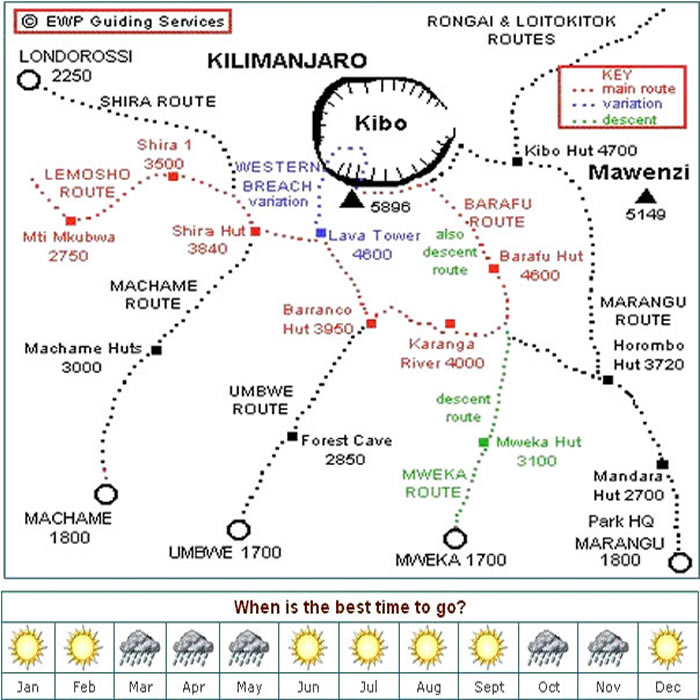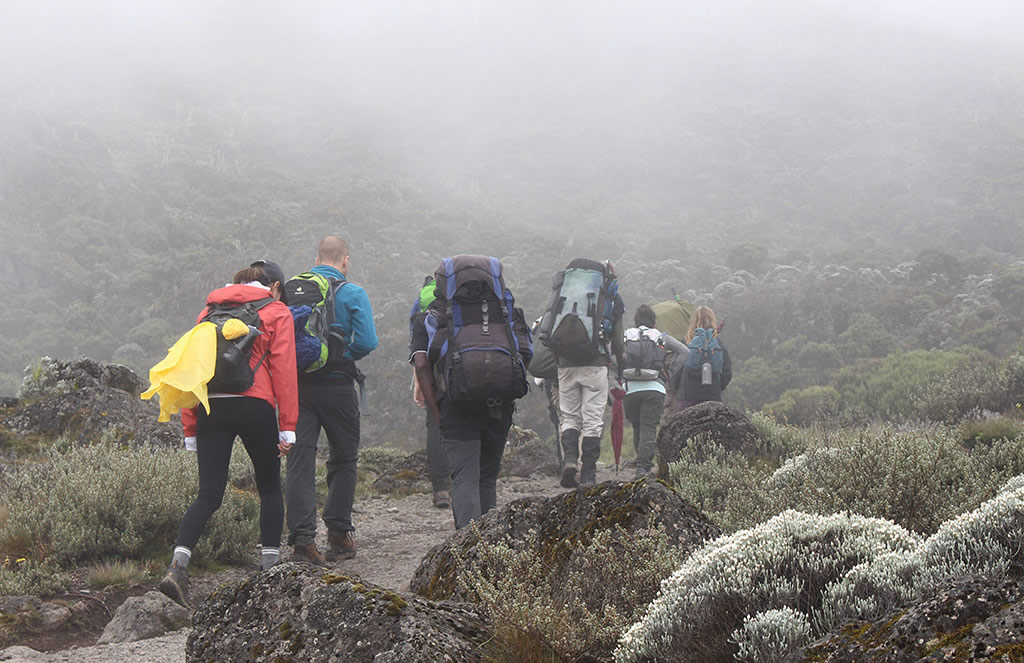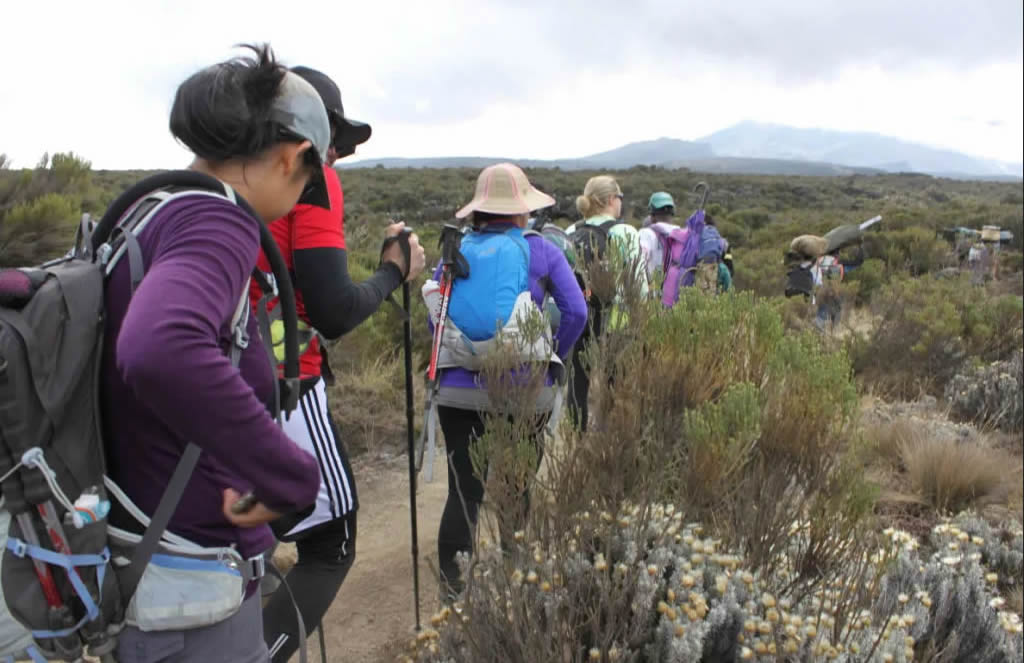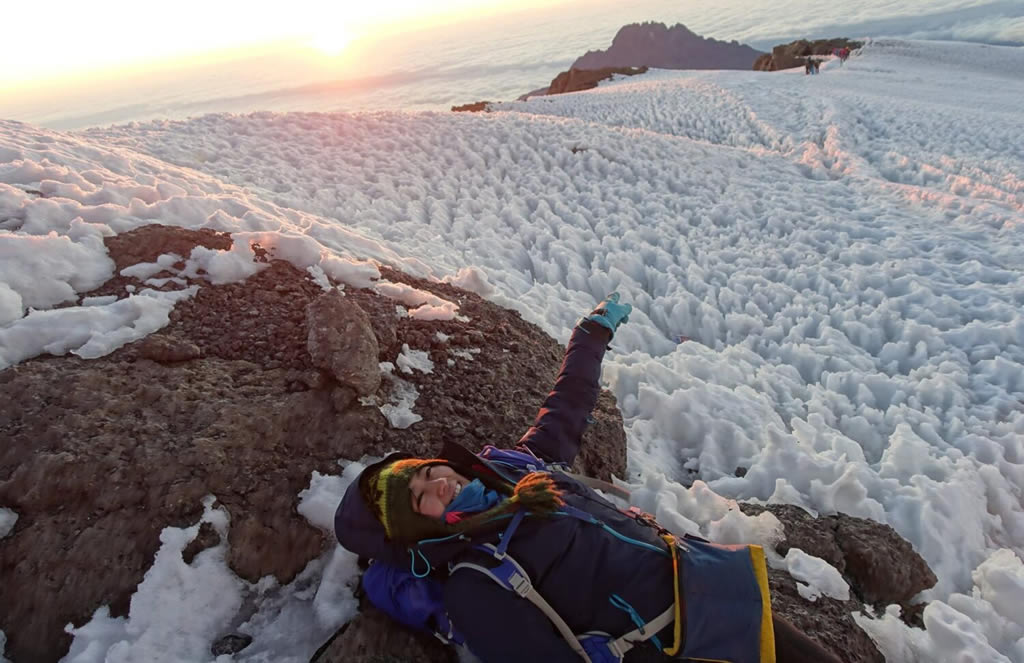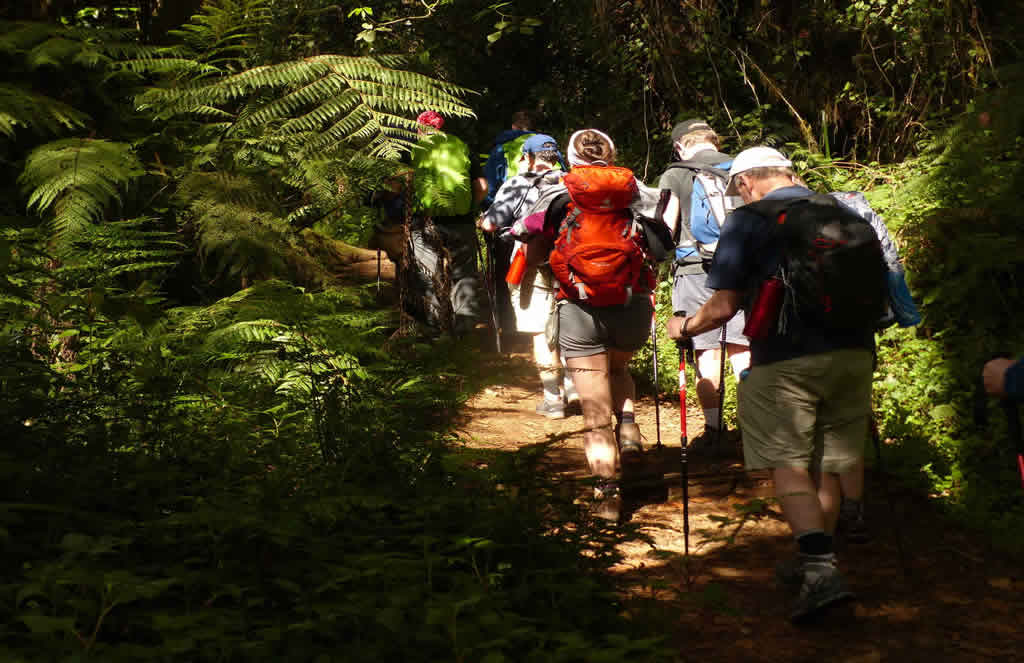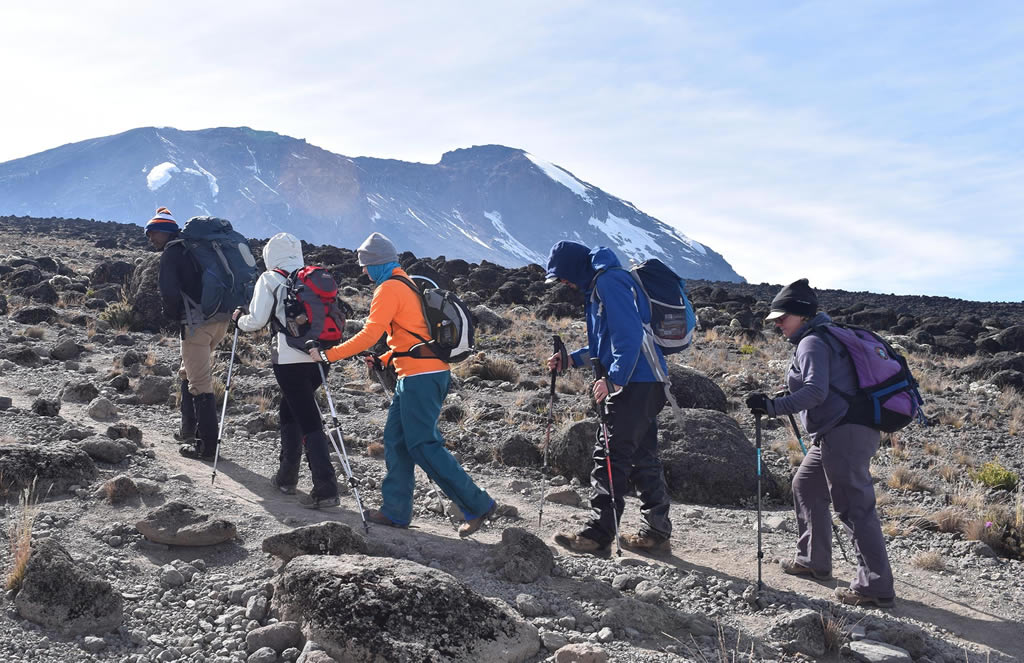6 DAYS MACHAME ROUTE ITINERARY
| 6 Days | Max People : 26 | Jan 01 - Dec 31 |
| Min Age : 10+ | Pickup : Airport | Langauge - English and Others |
- DESCRIPTION
- ITINERARY
- INCLUSIONS
- ENQUIRE NOW
DESCRIPTION
6 Days Machame Route Itinerary
The Machame route is the most popular path. It is the route of choice for many people because it provides impressive views and a variety of habitats. About 50% of all climbers, and most seasoned climbers, choose the Machame route. It is also one of the cheaper routes due to its easy access and shorter itinerary.
The Machame route is also known as the Whiskey route, given its reputation for being a tough climb, in contrast to the easier Marangu route, which is known as the Coca Cola route. Unlike the gradual incline and hut accomodations found on the Marangu Route, the climbers on Machame hike steeper trails, for longer distances, while sleeping in tents. The Machame Route climb can be done in a minimum of six days (five nights) on the mountain. However, it is most often tackled over seven days (six nights), for a better altitude acclimatization schedule. The success rate is significantly higher when using the seven day route.
The trek begins at Machame Gate, located in the southern base of mountain, which is just a short drive from Moshi or Arusha. The hike starts within Kilimanjaro's lush, fertile, montane rainforest. As you might expect, the lower slopes receive a quite a bit of precipitation. The trail may be steep and slippery, so trekking poles are advised. As the route heads toward the Shira Plateau, the trees disappear and are replaced by low brush in the heather zone. Then the route climbs high to the volcanic plug, Lava Tower, before dropping and circling below the South IcYasinield. This circular pathway from Barranco to Karanga to Barafu is known as the southern circuit. As it traverses halfway around the mountain, climber's are exposed to great vistas. The long, strenuous approach to the summit is made from the east through endless switchbacks up increasingly loose gravel until we reach the crater rim at a mark known as Stella Point. Then the route is relatively flat for another hour to Uhuru Peak - the top of Mount Kilimanjaro. The quick descent follows the Mweka trail.
The Machame Route is approximately 62 km/ 37 miles from gate to gate. It is designed for physically fit people with some hiking experience, but plenty of first time trekker use the route as well and do just fine. It is rated as one of Kilimanjaro's better routes and thus is recommended. It is certainly a better choice than the typical tourtist's route - Marangu.
ITINERARY
Day 0 : Pickup to Airport
You will be picked up from airport. From there you will go to the hotel in Moshi for an orientation on your trek. Your guides will be there to provide you with details on your trek and will also check your trekking gears.Day 1: Machame Gate (1,800m/5,905ft) to Machame Camp (3,000m/9,840ft)
Elevation Gain: 1,200 meters, 3,935 feetAt 8am, leave Moshi for Machame Gate, where you will meet our porters, guides, and cooks that will spend the next seven days trekking with you to Uhuru Peak, the roof of Africa. Once you arrive, wait at the gate while we register your climb and the porters and guides make final preparations. Your first day's destination is Machame Camp. Each day, porters and cooks will walk ahead to set up the camp in time for your arrival. On the first day, hike through the moss-covered trees of Kilimanjaro's cloud forest. The forest will thin at the end of the hike and vegetation will change to include heathers, tall grasses and wildflowers. If the weather is clear, view the surrounding area and your ultimate destination, Kibo Peak.
Day 2: Machame Camp (3,000m/9,840ft) to Shira Camp (3,840m/12,600ft)
Elevation Gain: 840 meters, 2,760 feetAlthough considered to be the easiest day on the Machame Route, today's trek includes several uphill sections. Carry plenty of drinking water, as the exposed hike can be hot on a clear day. There are several viewpoints from which you can see the plains and forests below and Kibo and Mawenzi peaks above. As you gain altitude, notice the change in vegetation. The trees diminish in size, giving way to Kilimanjaro's famous high altitude plants, Scenecio kilimanjari and Lobelia deckenii. After eating lunch, climb the Shira Plateau, created when Kibo's lava flows filled the Shira crater. Continue to Shira Camp, where you will relax for the rest of the day. Kibo lies to the west and Mount Meru to the east.
Day 3: Shira Camp (3,840m/12,600ft) to Barranco Camp (3,950m/12,960ft)
Total Elevation Gain: 690 meters, 2,264 feetAlthough this up and down day ends with an elevation gain of only 110 meters, by early afternoon you will have climbed 690 meters to a height of 4,530 meters before beginning your descent to Barranco Camp. This day is crucial for acclimatization. After breakfast, hike east on the Shira Plateau before reaching the junction for the Shira and Lemosho Routes. Continue on through the barren landscape before stopping for lunch. Shortly after lunch, reach the highest point of the day before descending quickly to Barranco Camp. Faster hikers can take a detour via Lava Tower, a 300-foot lava formation jutting out of the mountainside. Barranco Camp, set among stands of Senecio kilimanjari, is considered to be the most scenic campsite on the Machame Route.
Day 4: Barranco Camp (3,950m/12,960ft) to Barafu Camp (4,600m/15,100ft) Elevation Gain: 600 meters, 2,140 feet
Leave Barranco Camp after an early breakfast to begin the long hike to Barafu Camp. The day begins with an hour and a half scramble up the Barranco Wall. This is the hardest part of the day and in some places you will have to use your hands to pull your body up. After reaching the top, you will make a short descent into the greener Karanga Valley before continuing on to Barafu Camp. On the way to Barafu, view several of Kibo's glaciers as well as the junction that connects the descent route, Mweka, with the Machame trail. During day four, hike by the Heim, Kersten and Decken Glaciers. Although the way to Barafu is bleak, alpine desert with little vegetation, Barafu Camp offers stunning views of Kibo and Mawenzi peaks, and Rebmann Glacier. Try to sleep as soon as you finish dinner as you will be waking up at midnight for your summit hike.
Day 5: Barafu Camp (4,600m/15,100ft) to Uhuru Peak (5,895m/19,340ft) to Mweka Camp (3,100m/10,170ft)
Elevation Gain: 1,295 meters, 4,240 feetElevation Loss: 2,795 meters, 9,170 feet
Around midnight, begin the final ascent to Uhuru Peak, the highest point in Africa. For the next six hours, hike by the light of your headlamp. The ascent to the crater rim is the most challenging part of the entire trek. The trail is very steep until you reach the crater rim at Stella Point. The hike from Stella Point to Uhuru Peak is a gradual climb and, as far as hikes go, not very difficult. The altitude, however, makes the hike long and tiring. The crater rim hike takes approximately one hour. Upon reaching Uhuru, take photos of your guide and group at the peak before beginning the descent to Mweka Camp. On the way down from Uhuru, enjoy views of the mountain, crater, clouds and glaciers.
At Barafu Camp, eat breakfast and take a short break. You still have another three to five hours to go before reaching Mweka Camp.
Day 6: Mweka Camp (3,100m/10,170ft) to Mweka Gate (1,500m/4,920ft)
Elevation Loss: 1,600 meters, 5,250 feetAfter breakfast, finish the trek with a descent to Mweka Gate. Your last hike on Kilimanjaro is a beautiful one, passing through Kilimanjaro's cloud forest. Watch your step during the descent, as the trail can be slippery. Our vehicles will be waiting at the lower station of Mweka Gate to take you back to Moshi. You will be able to buy t-shirts and sodas at the gate.
Dinner and overnight at PANAMA GARDEN RESORT or similar hotel in Moshi
INCLUSIONS
INCLUDED IN THE PACKAGES
Private transport from the hotel to the Park s gate (starting point for the climb), and transport back to the hotel after the climbAll National Park entry fees
All camping fees
2 night's hotel the night before and the night after the climb, with breakfast included
Kilimanjaro National Park certificate for your successful summit attempt
Qualified medical guides
Breakfast, lunch and dinner, as well as hot drinks on the mountain
Salaries for Guides, cook and porters.
Rescue fees (Kilimanjaro Park rescue team fees)
Government taxes
Pickup and drop off to Airport
Evacuation services
Hut fees [ Marangu route }
Friendly and competent Trained Mountain Guides, assistant guides, porters and professional cooks.
3 full fresh meals daily. We provide fresh food on the mountain in plentiful and well prepared by skilled professional cooks(we also consider your choice of food that you would prefer -Vegetarian and Non Vegetarian). Menu especially designed for climbers.
Hot drinks on the mountain and Hot water for washing will be provide everyday on the mountain.
Quality specious tents, sleeping mats, camping tables ,camping chairs and Mess/Dining Tent.(Not applicable on the Marangu route as accommodation is in A-frame huts)
Supplementary Portable Oxygen and Complete First Aid Kit (used in case of emergency only)
Pulse oxy-meter carried by all chief guides
3-4 liters of mineral/treated water (per Climber) provided daily during the climb
***Portable toilet available at an additional cost (There are public toilets on the mountain)
NOT INCLUDED IN OUR PACKAGES PRICES
Items of a personal natureTips for guides, porters and cook (average tip is anything from US$250 to US$ 350 per hiker - depending on number of days / how many hikers in the group and route chosen)
Personal Hiking/Trekking gears (Some Gears are available for Rent)
Snacks, personal medicine
Meals, drinks and snacks not specified in hotel
ENQUIRE NOW
